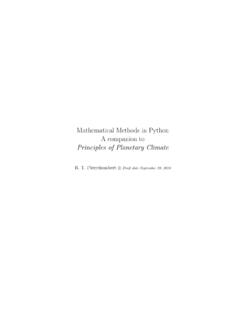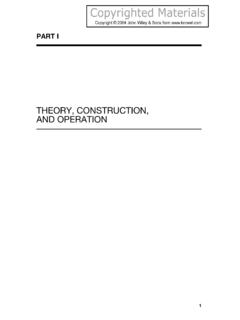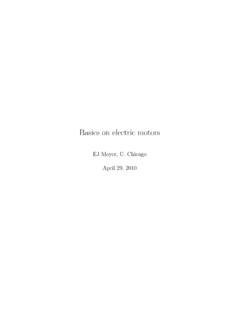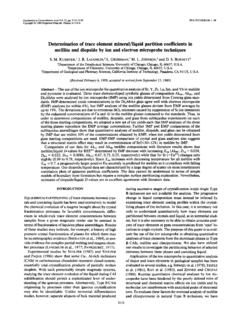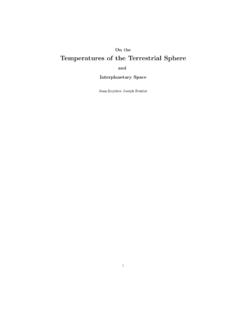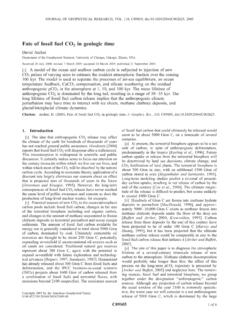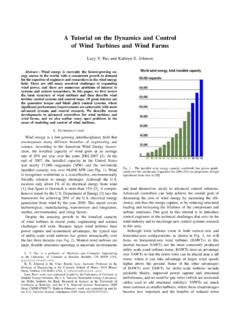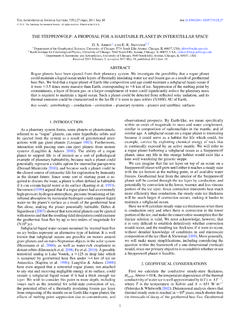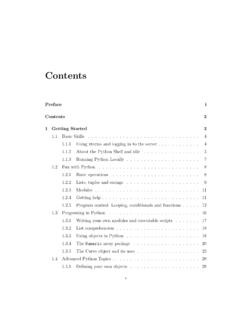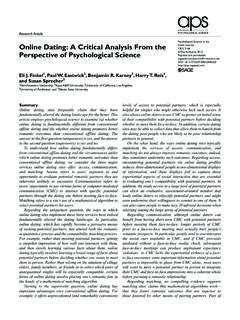Transcription of THEORY, CONSTRUCTION, AND OPERATION
1 PART I. THEORY, CONSTRUCTION, AND OPERATION . 1. CHAPTER 1. principles OF OPERATION . OF SYNCHRONOUS MACHINES. The synchronous electrical generator (also called alternator) belongs to the family of electric rotating machines. Other members of the family are the direct- current (dc) motor or generator, the induction motor or generator, and a number of derivatives of all these three. What is common to all the members of this fam- ily is that the basic physical process involved in their OPERATION is the conversion of electromagnetic energy to mechanical energy, and vice versa. Therefore, to comprehend the physical principles governing the OPERATION of electric rotating machines, one has to understand some rudiments of electrical and mechanical engineering. Chapter 1 is written for those who are involved in operating, maintaining and trouble-shooting electrical generators, and who want to acquire a better under- standing of the principles governing the machine's design and OPERATION , but who do not have an electrical engineering background.
2 The chapter starts by introducing the rudiments of electricity and magnetism, quickly building up to a description of the basic laws of physics governing the OPERATION of the syn- chronous electric machine, which is the type of machine all turbogenerators belong to. INTRODUCTION TO BASIC NOTIONS ON ELECTRIC POWER. Magnetism and Electromagnetism Certain materials found in nature exhibit a tendency to attract or repeal each other. These materials, called magnets, are also called ferromagnetic because they include the element iron as one of their constituting elements. OPERATION and Maintenance of Large Turbo Generators, by Geoff Klempner and Isidor Kerszenbaum ISBN 0-471-61447-5 Copyright 2004 John Wiley & Sons, Inc. 3. 4 principles OF OPERATION OF SYNCHRONOUS MACHINES. Magnets always have two poles: one called north; the other called south. Two north poles always repel each other, as do two south poles. However, north and south poles always attract each other.
3 A magnetic field is defined as a physical field established between to poles. Its intensity and direction determine the forces of attraction or repulsion existing between the two magnets. Figures and are typical representations of two interacting magnetic poles, and the magnetic field established between them. Magnets are found in nature in all sorts of shapes and chemical constitution. Magnets used in industry are artificially made. Magnets that sustain their mag- netism for long periods of time are denominated permanent magnets. These are widely used in several types of electric rotating machines, including synchronous machines. However, due to mechanical, as well as operational reasons, perma- nent magnets in synchronous machines are restricted to those with ratings much lower than large turbine-driven generators, which is the subject of this book. Turbine-driven generators (for short: turbogenerators) take advantage of the fact that magnetic fields can be created by the flow of electric currents in conductors.
4 See Figure N S. Lines of Force Fig. Schematic representation of two magnetic poles of opposite polarity, and the magnetic field between them shown as lines of force.. N N. Lines of Force Fig. Schematic representation of two north poles, and the magnetic field between them. South poles will create similar field patterns, but the lines of force will point toward the poles. INTRODUCTION TO BASIC NOTIONS ON ELECTRIC POWER 5. Conductor Electric Current Lines of Force Fig. Schematic representation of a magnetic field created by the flow of current in a conductor. The direction of the lines of force is given by the law of the screwdriver : mentally follow the movement of a screw as it is screwed in the same direction as that of the current; the lines of force will then follow the circular direction of the head of the screw. The magnetic lines of force are perpendicular to the direction of current. A very useful phenomenon is that, forming the conductor into the shape of a coil can augment the intensity of the magnetic field created by the flow of current through the conductor.
5 In this manner, as more turns are added to the coil, the same current produces larger and larger magnetic fields. For practical reasons all magnetic fields created by current in a machine are generated in coils. See Figure Electricity Electricity is the flow of positive or negative charges. Electricity can flow in electrically conducting elements (called conductors), or it can flow as clouds of Lines of Force Current Flow Fig. Schematic representation of a magnetic field produced by the flow of electric current in a coil-shaped conductor. 6 principles OF OPERATION OF SYNCHRONOUS MACHINES. (a ). (b ). Fig. Electricity. (a) Ionic clouds of positive and negative currents. The positive clouds are normally atoms that lost one or more electrons; the negative clouds are normally free electrons. (b) The flow of electrons inside a conductor material, for example, copper. ions in space or within gases. As it will be shown in later chapters, both types of electrical conduction are found in turbogenerators.
6 See Figure ELECTRICAL MECHANICAL EQUIVALENCE. There is an interesting equivalence between the various parameters describ- ing electrical and mechanical forms of energy. People with either electrical or mechanical backgrounds find this equivalence useful to the understanding of the physical process in either form of energy. Figure describes the various forms of electrical-mechanical equivalence. ALTERNATED CIRCUITS (AC). As it will be shown later, alternators operate with both alternating (ac) and direct-current (dc) electric power. The dc can be considered a particular case of the general ac, with frequency equal to zero. The frequency of an alternated circuit is measured by the number of times the currents and/or voltages change direction (polarity) in a unit of time. The Hertz is the universally accepted unit of frequency, and measures cycles per second. One ALTERNATED CIRCUITS (AC) 7. Fig. Electrical-mechanical equivalence.
7 Hz equals one cycle per second. Alternated currents and voltages encountered in the world of industrial electric power are for all practical purposes of constant frequency. This is important because periodic systems, namely systems that have constant frequency, allow the currents and voltages to be represented by phasors. A phasor is a rotating vector. The benefit of using phasors in electrical engi- neering analysis is that it greatly simplifies the calculations required to solve circuit problems. Figure depicts a phasor of magnitude E, and its corresponding sinusoidal trace representing the instantaneous value of the quantity e. The magnitude E. represents the maximum value of e. When a sinusoidal voltage is applied to a closed circuit, a current will flow in it. After a while the current will have a sinusoidal shape (this is called the steady- state current component) and the same frequency as the voltage. An interesting 8 principles OF OPERATION OF SYNCHRONOUS MACHINES.
8 Voltage (e). E (phasor).. Fig. A phasor E, that can represent the voltage impressed on a circuit. The phasor is made of a vector with magnitude proportional to the magnitude of E, rotating at a constant rotational speed . The convention is that phasors rotate counterclockwise. The vertical projection of the phasor results in a sinusoidal representing the instantaneous voltage e existing at any time. In the graph, = t, where t is the time elapsed from its zero crossing. phenomenon in periodic circuits is that the resulting angle between the applied voltage and the current depends on certain characteristics of the circuit. These characteristics can be classified as being resistive, capacitive, and inductive. The angle between the voltage and the current in the circuit is called the power angle. The cosine of the same angle is called the power factor of the circuit, or for short, the PF. Note: As it will be shown latter, in synchronous machines the term power angle is used to identify a different concept.
9 To avoid confusion, in this book the angle between the current and the voltage in the circuit will therefore be identified by the power factor.. In the case of a circuit having only resistances, the voltages and currents are in phase, meaning the angle between them equals zero. Figure shows the various parameters encountered in a resistive circuit. It is important to note that resistances have the property of generating heat when a current flows through them. The heat generated equals the square of the current times the value of the resistance. When the current is measured in amperes and the resistance in ohms, the resulting power dissipated as heat is given in watts. In electrical machines this heat represents a loss of energy. It will be shown later that one of the fundamental requirements in designing an electric machine is the efficient removal of these resistive losses, with the purpose of limiting the undesirable temperature rise of the internal components of the machine.
10 In resistive circuits the instantaneous power delivered by the source to the load equals the product of the instantaneous values of the voltage and the current. When the same sinusoidal voltage is applied across the terminals of a circuit with capacitive or inductive characteristics, the steady-state current will exhibit an angular (or time) displacement vis-`a-vis the driving voltage. The magnitude ALTERNATED CIRCUITS (AC) 9. Fig. Alternating circuits (resistive). Schematic representation of a sinusoidal voltage of magnitude E applied on a circuit with a resistive load R. The schematics shows the resultant current i in phase with the voltage v. It also shows the phasor representation of the voltage and current. of the angle (or power factor) depends on how capacitive or inductive the load is. In a purely capacitive circuit, the current will lead the voltage by 90 , while in a purely inductive one, the current will lag the voltage by 90 (see Fig.)
